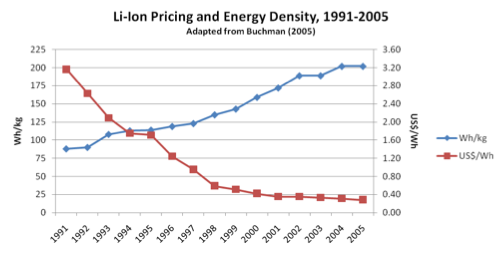In the long run, there’s no avoiding energy storage for a 100% renewable energy society. The two major sources of renewable power are wind and sun, and they are either fickle or reliably not available at night.
The problem is that the simplest energy storage option for electricity is batteries, and this image from Wikipedia (hat tip to Robert Rapier) illustrates a significant technical barrier: our simplest option is also among the least energy dense material we have.
There are two likely paths to a 100% renewable energy future in these circumstances: mass distribution of low-density, low-cost storage or higher density storage.
In some respects, we’re already moving along the first path. Widespread availability of battery-powered iPads and laptops has led to great strides in greater energy density of batteries and lower cost. The following chart (used in our Democratizing the Electricity System report) illustrates the changes in the past 15 years.
Electrified transportation is the next iteration, using batteries that are orders of magnitude larger (e.g. a Nissan Leaf battery with 23 kW-hour capacity has 300 times the storage capacity of a Macbook Pro laptop battery). These are 1st generation commercial batteries, with enormous improvements in capacity and cost likely. Furthermore, with hundreds of millions of cars, the sheer storage capacity of the U.S. vehicle fleet will be tremendous (over 4 billion kilowatt-hours) as electric vehicles become the drive train standard. And a recent study has shown that the storage capacity of 2.1 million vehicles can enable an additional 10 gigawatts of wind power on the grid (in the Northwest).
The Germans, ever the clean energy integration leaders with over 15% of their electricity sourced from wind and solar, have also looked at electricity to hydrogen storage (a look at the above chart suggests the energy density of hydrogen has some advantages). While not as efficient as batteries (two-thirds of power is lost, compared to 10-20% round trip for batteries), the resulting hydrogen can be used in natural gas power plants to provide backup power or piped into the natural gas network for building heat. It’s not only flexible but it also could be useful because wind power in particular can peak during periods of low electricity use (nighttime).
The good (or bad, depending on your perspective) news for the U.S. is that renewable energy is such a small fraction of total electricity generation that energy storage isn’t yet necessary in any significant quantity. Existing power plants have sufficient spare capacity to fill the gaps left by variable renewables. While this state of affairs doesn’t endear the U.S. power industry to environmentalists, it does mean there is time to see storage technology improve.
I’m optimistic.




